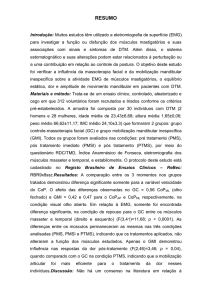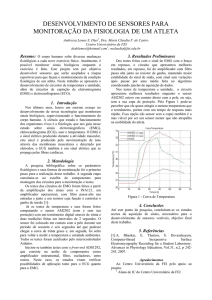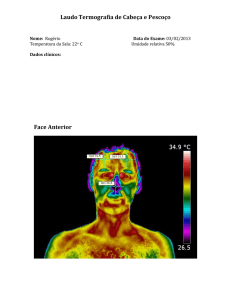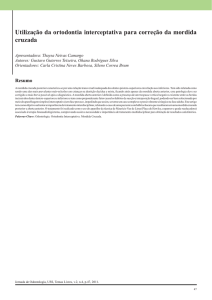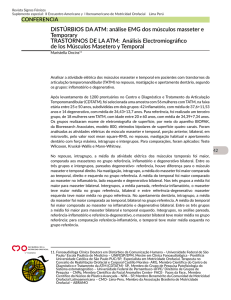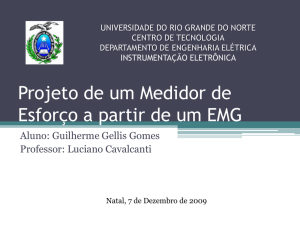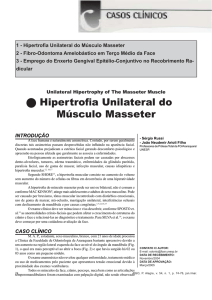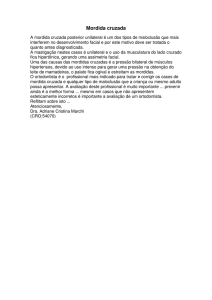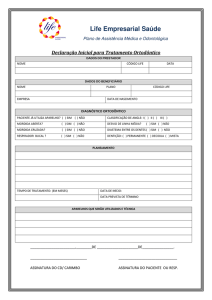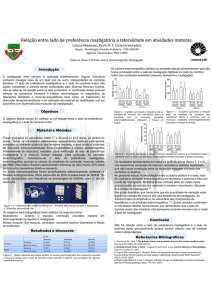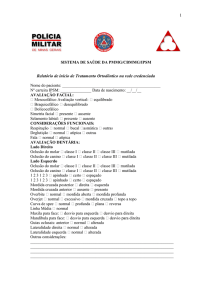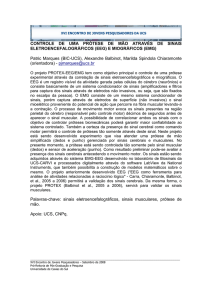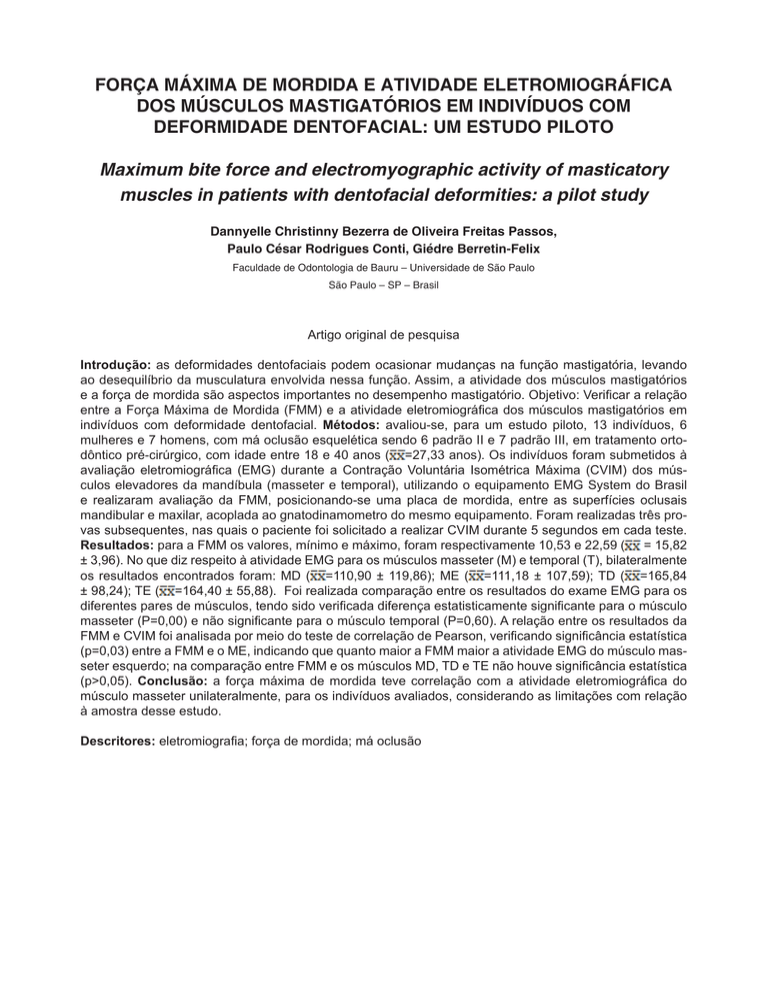
FORÇA MÁXIMA DE MORDIDA E ATIVIDADE ELETROMIOGRÁFICA
DOS MÚSCULOS MASTIGATÓRIOS EM INDIVÍDUOS COM
DEFORMIDADE DENTOFACIAL: UM ESTUDO PILOTO
Maximum bite force and electromyographic activity of masticatory
muscles in patients with dentofacial deformities: a pilot study
Dannyelle Christinny Bezerra de Oliveira Freitas Passos,
Paulo César Rodrigues Conti, Giédre Berretin-Felix
Faculdade de Odontologia de Bauru – Universidade de São Paulo
São Paulo – SP – Brasil
Artigo original de pesquisa
Introdução: as deformidades dentofaciais podem ocasionar mudanças na função mastigatória, levando
ao desequilíbrio da musculatura envolvida nessa função. Assim, a atividade dos músculos mastigatórios
e a força de mordida são aspectos importantes no desempenho mastigatório. Objetivo: Verificar a relação
entre a Força Máxima de Mordida (FMM) e a atividade eletromiográfica dos músculos mastigatórios em
indivíduos com deformidade dentofacial. Métodos: avaliou-se, para um estudo piloto, 13 indivíduos, 6
mulheres e 7 homens, com má oclusão esquelética sendo 6 padrão II e 7 padrão III, em tratamento ortodôntico pré-cirúrgico, com idade entre 18 e 40 anos ( =27,33 anos). Os indivíduos foram submetidos à
avaliação eletromiográfica (EMG) durante a Contração Voluntária Isométrica Máxima (CVIM) dos músculos elevadores da mandíbula (masseter e temporal), utilizando o equipamento EMG System do Brasil
e realizaram avaliação da FMM, posicionando-se uma placa de mordida, entre as superfícies oclusais
mandibular e maxilar, acoplada ao gnatodinamometro do mesmo equipamento. Foram realizadas três provas subsequentes, nas quais o paciente foi solicitado a realizar CVIM durante 5 segundos em cada teste.
Resultados: para a FMM os valores, mínimo e máximo, foram respectivamente 10,53 e 22,59 ( = 15,82
± 3,96). No que diz respeito à atividade EMG para os músculos masseter (M) e temporal (T), bilateralmente
os resultados encontrados foram: MD ( =110,90 ± 119,86); ME ( =111,18 ± 107,59); TD ( =165,84
± 98,24); TE ( =164,40 ± 55,88). Foi realizada comparação entre os resultados do exame EMG para os
diferentes pares de músculos, tendo sido verificada diferença estatisticamente significante para o músculo
masseter (P=0,00) e não significante para o músculo temporal (P=0,60). A relação entre os resultados da
FMM e CVIM foi analisada por meio do teste de correlação de Pearson, verificando significância estatística
(p=0,03) entre a FMM e o ME, indicando que quanto maior a FMM maior a atividade EMG do músculo masseter esquerdo; na comparação entre FMM e os músculos MD, TD e TE não houve significância estatística
(p>0,05). Conclusão: a força máxima de mordida teve correlação com a atividade eletromiográfica do
músculo masseter unilateralmente, para os indivíduos avaliados, considerando as limitações com relação
à amostra desse estudo.
Descritores: eletromiografia; força de mordida; má oclusão
MAXIMUM BITE FORCE AND ELECTROMYOGRAPHY ACTIVITY
OF MASTICATORY MUSCLES IN PATIENTS WITH DENTOFACIAL
DEFORMITIES: A PILOT STUDY
Força máxima de mordida e atividade eletromiográfica
dos músculos mastigatórios em indivíduos
com deformidade dentofacial: um estudo piloto
Dannyelle Christinny Bezerra de Oliveira Freitas Passos,
Paulo César Rodrigues Conti, Giédre Berretin-Felix
Faculdade de Odontologia de Bauru – Universidade de São Paulo
Bauru – São Paulo – Brasil
Original Article
Introduction: dentofacial deformities may cause changes in the masticator function, leading to imbalance
in the muscles involved in this function. The activity of masticatory muscles and bite force are important
in the performance of masticator function. Objective: to investigate the relationship between Maximum
Bite Force (MBF) and electromyographic activity of masticatory muscles in dentofacial deformity patients.
Methods: this pilot study evaluated, 13 individuals, six women and seven men, six with skeletal malocclusion
pattern II and seven patterns III in preoperative orthodontic treatment, with age ranging between 18
and 40 years (mean 27,33 years). The subjects were submitted to electromyography evaluation (EMG)
during the Maximum Isometric Voluntary Contraction (MIVC) of the jaw elevator muscles (masseter and
temporal) using equipment EMG System of Brazil. The MBF were evaluated using a bite plate between the
mandibular and maxillary occlusal surfaces, coupled to gnathodynamometer in the same equipment. There
were three tests, in which the patient was asked to perform MIVC for five seconds in each test. Results:
for the MBF values the minimum and maximum was, respectively, 10.53 and 22.59 ( = 15.82 ± 3.96). The
EMG activity, mean ± standard deviation, for the masseter (M) and temporal (T) in both sides were: MR
( = 110.90 ± 119.86), ML ( = 111.18 ± 107.59); TR ( = 165.84 ± 98.24), TL ( = 164.40 ± 55.88). The
results of EMG examination comparing different pairs of muscles showed statistically significant differences
for the masseter (P = 0.00) and not significant for the temporal muscle (P = 0.60). The relationship between
MBF and the results of the MIVC was analyzed using the Pearson correlation test, checking statistical
significance (p = 0.03) between the MBF and left masseter muscle (ML), indicating that an increase in MBF
was related to an increase in EMG activity of the masseter left muscle; the comparison between MBF and
muscles MR, TR and TL was no statistical significance (p> 0.05). Conclusion: the maximum bite force
was correlated with the electromyography activity of masseter muscle in only one side, for the individuals
evaluated. We should consider the limitations regarding the sample for this study.
Keywords: electromyography; bite force; malocclusion

